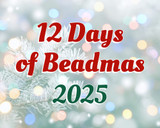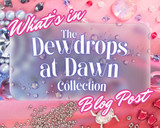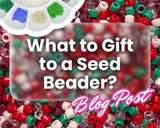Frequently Asked Questions About Seed Beads
Jewelry made from glass seed beads is currently topping the lists of most trendy and stylish jewelry. Seed beads are beautiful and versatile and allow for the creation of many types of unique jewelry designs which have taken off in the last few years such as long beaded fringe earrings, African waist beads, dainty beaded choker necklaces and beaded bangle bracelets.
If you want to learn how to easily make your own jewelry and accessories with seed beads but you are not sure what is and 11/0 and what is a Delica, you’ve come to the right place! Below is our comprehensive guide explaining everything you need to know about different types of seed beads so you can decide which ones are best for your next beaded jewelry project.
What are seed beads?

The term ‘seed bead’ is a broad term that refers to any very small bead that is preferred for bead weaving or bead embroidery applications as well as for any very dainty designs. Seed beads come in a variety of shapes including round, cylindrical, long tube (known as a bugle), triangle, square, doughnut shaped, and flat tile shaped. What differentiates seed beads from other types of beads is their size. They are typically very tiny.
What are Toho, Miyuki, Matubo, and Preciosa beads?

These names refer to the top-quality brands of glass seed beads on the market. Toho and Miyuki are brands of seed beads made in Japan. Toho also makes several types of beading thread that work well with their beads. Preciosa and Matubo are brands of beads made in the Czech Republic. Preciosa makes both crystal as well as glass seed beads and Matubo is also known for various other shapes of glass beads in addition to seed beads, the most popular of which are the SuperDuo Czech Beads. Learn more about Czech Glass Beads here!
How do seed bead sizes work?
Most commonly you will see seed beads sizes listed in this fashion: 11/0 or 15/0, sometimes they will be stylized as 11° or 15°. This is pronounced as “eleven oh” and “fifteen oh” and this sizing system is called aught sizes or oh sizes. The higher the number, the smaller the beads so 15/0 are the smallest seed beads while 6/0 are the largest traditional seed bead size (at Eureka we also carry very large 3/0 seed beads from Toho!). The sizing was traditionally based on how many beads could fit in the space of one inch so more small beads and less larger beads. This traditional rule of thumb is no longer used and you will find that the same size bead from different manufacturers may vary both in size and in shape even though they are both considered 11/0 rounds.
In most projects, these small variations will not make a difference but it can be an issue in specific projects so it is always best to stitch up a swatch using the beads you’d like to use to be sure that they work in the bead weaving design you would like to attempt. Using the wrong type of beads called for in a pattern is one of the biggest mistakes made by newbie beaders so it’s important to pay attention to the beads you are using and make sure you have the right ones.
Typically you will find that Czech seed beads tend to be more rounded on the sides like a donut and not as tall as Japanese rounds. Japanese round seed beads are usually taller and have the same height as their cylindrical counterparts.
What is a Delica bead?

A Delica bead is a cylindrical shaped bead made by Miyuki, the well known Japanese seed bead manufacturer. What can get confusing for new beaders is that sometimes the term ‘Delica’ is used interchangeably with ‘cylindrical.’ Sort of in the same way that ‘Bandaid’ now refers to all adhesive plasters whether they are Bandaid brand or not, you will see people refer to Delicas even if they are not made by Miyuki. Adding to the confusion, some people refer to only round seed beads as ‘seed beads’ and class all cylindrical seed beads as ‘Delicas.’
However, it is generally understood that seed beads are all very small beads of which cylindrical, round, tube, triangle, cube and doughnut are some of the available shapes. Terms like ‘Delica,’ ‘Aiko’ and ‘Treasure’ are product lines from different manufacturers all of which refer to cylindrical shaped beads. Delicas are made by Miyuki and Aikos and Treasures are made by Toho. The difference between Aikos and Treasures are that the Aikos are manufactured to the absolute highest quality standard and are the most uniform of all cylindrical beads on the market. You will not have to do any culling of your beads if you use Aikos.
What does culling beads mean?

You’ve probably seen people refer to culling your beads, especially with seed beading. Because of the way glass seed beads are made, every package of beads will usually come with some beads that are a little off in terms of size, shape or hole size. With some brands or styles this is a bigger issue than with others. For example, Aiko cylindrical beads from Toho require almost no culling because they are ‘pre culled’ at the factory. What it means is that you will go through your package of beads and separate out any beads that are either smaller or larger than most of the other beads (as well as removing any broken or damaged beads).
Depending on your needs and the type of project you are planning to design, you can cull by removing and discarding any off sizes or just separate the beads into several piles so you can still use the off sized beads to fill a gap or to increase or decrease your bead work. It’s also a good idea to remove beads with defective holes like ones that are very small which can present a problem later on if you have to make several passes of thread through the bead or holes that are too large which could means that the bead is weaker and more likely to break off.
No name brand beads tend to have less quality control in the manufacturing process so their sizes and shapes can vary much more than quality beads from known brands like Miyuki, Toho, Matubo and Preciosa Ornela. You might find that you’re better off splurging on slightly more expensive beads to save yourself the headache of culling off half your beads.
What are gold lined or silver lined seed beads?

When you use the term ‘lined’ used in the color name of a seed bead this typically refers to a special lining on the inside of the hole. Adding these linings increases the variety of effects and color options available to seed beaders. By combining a transparent or translucent color of glass with a lining in the hold of the bead, you can add more sparkle, add more depth as well as change the overall color of the bead.
Gold and silver lined beads have holes lined with either a gold colored metallic or a silver colored metallic and these beads tend to look as if ‘lit from within’ so therefore they are quite popular. You can also have other colors of lining that aren’t metallic. For example, a bead made from blue colored glass can have a yellow lining to create a beautiful green looking bead. Many of the most intense colors work best as a lining rather than a dye or coat so you will frequently see neon lined beads. With a neon lining, the bright color will wear much better because it is more protected from the elements and wear and tear.
What is a Bugle bead?

A bugle bead is a type of seed bead that is a long tube. Bugle beads typically do not use the aught sizing referred to above, rather they are sized by the length of the tube so 3mm bugles are 3mm long and 6mm bugles are 6mm long. Bugle beads are one of the classic seed bead shapes and have a beautiful effect, especially when woven together or in bead embroidery. Some of the best ones have transparent colored glass with a metal lined hole that sparkle beautifully in the light.
A more modern ‘twist’ on the bugle is a ‘twisted bugle’ shape which is similar to a bugle bead but has 6 facets rather than being completely smooth all around and is then twisted to create a lovely spiraling effect.
What is a Charlotte bead?

A Charlotte seed bead is a round seed bead with one facet cut into the side of the bead. Charlottes are popular because they give a really understated sparkle with the single facet so you can use many of them in your beaded jewelry design without making your project overly showy. They are good, understated beads with just a touch more glamour than a typical round seed bead.
What seed bead projects are best for beginners?
As a beginning beader, the best projects to start with are simple stringing projects. All you need is a beading needle, beading thread, a selection of seed beads and some type of clasp and you can get started making simple beaded bracelets and necklaces!
Here are our favorite beginner seed bead tutorials to follow along with:
1. The Basics of Bead Embroidery
2. The Atlantis Wave Ring
3. The Fan Dance Earrings
4. Beaded Daisy Chain
We hope this list of frequently asked questions about seed beads helped to answer some of your most burning questions about seed beads and beaded jewelry making. Stay tuned for Part 2 where we will tackle some other common questions and points of confusion such as:
- What does galvanized bead mean?
- What does duracoat mean?
- What does permafinish mean?
Got any other questions for us that you can’t find the answers to? Send us your question to service@eurekacrystalbeads.com and we’ll try to answer it in an upcoming blog post!
Related Blog: Beads for Jewelry Making: A Comprehensive Guide












